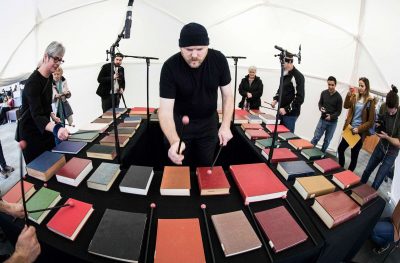
Prof. Jesse Stewart plays a bibliophone—a xylophone made out of hardcover books—in the MacOdrum Library.
By Emily Cook, TLS Staff Writer
Beyond instruments and traditional orchestras, Jesse Stewart believes music has the power to bring people together and change the world. And he’s playing a role in that, starting in the classroom.
Stewart, a faculty member with Carleton University’s music program, was recognized with a 2017 D2L Innovation Award in Teaching and Learning. His philosophy for music-making, teaching and learning is simple.
“I would like to make music with as many people as possible, from as many different kinds of backgrounds as possible,” he says.
Music is now being listened to and experienced in whole new ways because of technology, says Stewart, and it’s changing the roles of composer, performer and audience member. He encourages students in his composition class to reconsider these roles through a web-based learning project.
“Rather than relying on received ideas of what each of those things entails, I try to encourage students to think critically about them,” he says.
One group of students took that concept and built the Carleton University Soundmap. They recorded sounds across campus and input them into an online map. The viewer interacts with the map, creating a unique kind of instrument.
Stewart says he believes students are active agents in their learning. So when he wanted to expand his instrumentation and orchestration course textbook to include non-Western symphony instruments, he turned to his students.
Stewart had his students complete assignments on different instruments and then put them together in an online textbook for future classes.
“The reality is that composers today are using all kinds of different instruments and are writing for all kinds of different instruments in their work,” he says.
The orchestras in Stewart’s ensemble course are perfect examples of this. Stewart acts as a facilitator, while as a group, students create an ensemble that is unique and innovative in its approach to instrumentation. One ensemble called The Balloon Orchestra used latex balloons as musical instruments. Another, Paperphonics, explored the use of paper and cardboard. The H2Orchestra experimented with the sonic potential of water.
“I see that as one of my responsibilities as an educator, to hopefully expose students in my classes to things they might not come across otherwise,” he says.
But Stewart’s impact as an educator extends well beyond the classroom and into the community.
His Music and Social Justice course explores music as an agent for positive social change. One of his classes visited an Ottawa-area school and made musical instruments with the children, many of who come from disadvantaged backgrounds.
“I hope that maybe those kids will think, ‘Music can be part of my life,’” he says.
Stewart says he recognizes many people experience barriers to music, which he believes is a fundamental right.
“I believe music has a very important role to play, not just in modeling social justice, but in actually bringing about social justice,” he says. “I think as a society, we have a responsibility to ensure everyone has access to the arts and to music.”